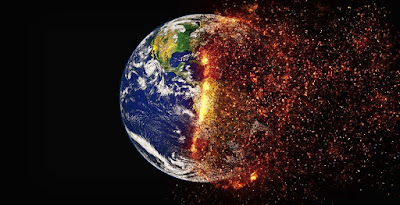What is dust and what are its effects?
 |
| Dust and meteorite formation |
What is dust and what are its effects and theories around it?
From small beginnings come great things
Last month, the night sky was filled with bright fireballs and thin streaks of light, this celestial light show was one of the greatest astronomical events of the year (the Perseids meteor shower).
In the best of years, the Perseids can produce up to 100 meteorites per hour, but the question is: Where do these meteorites come from? Surely the answer may surprise you.
Meteors are giant space rocks rushing at a tremendous speed across the universe, but what gives rise to the glamor and magic of meteor showers is dust, yes it is dust.
It turns out that most of the flashes and lines that we see during a meteor shower, are the result of small fragments, no larger than a grain of sand, passing through the upper atmosphere and as a result of friction and due to gravity will create fireworks and sparkling attractive lines.
Dust origin
But where did the dust come from? As it happens, the dust is a later addition to the universe. Since the universe was ancient, it consisted almost entirely of clouds of hydrogen and helium, which condensed over hundreds of millions of years into stars. Within the nuclei of these first stars, hydrogen and helium atoms fused to form heavier elements, and When those stars died and exploded in massive supernovae, they threw their debris into the void, so our physical world (everything living and nonliving) is made up of atoms dumped out from within the stars.
The surface view of dust, astronomy, and the effects of dust
Here on Earth, we tend to think of dust as a nuisance (a substance representing age, neglect, and putrefaction),
Dust on window sills clinging to mirrors tickles the sinuses and provokes sneezing.
In the blazing western United States, dust's cousin "ash" has blanketed everything, bringing to mind the major climate changess taking place across the planet.
But in fact, astronomers know, dust is not just the effects of catastrophic events but also a basic, building block of just about everything — from planets and stars to nebulae and galaxies, with some new hypotheses suggesting that without this more modest material, perhaps no Life itself had not arisen.
Saturn's rings - another beautiful sight in the night sky - are also the product of dust, as astronomers believe the rings are made up of the crushed remains of planets, moons, asteroids, and comets pulled into Saturn's orbit by its powerful gravity, as this mixture of rocks is organized The ice and dust are in separate bands, each orbiting the planet at different speeds.
If we could look at these rings from the surface of Saturn, the rings would appear to us as little more than a vague tinge and shapeless, like a raster painting, since at 800 million miles from the surface of the Earth, the rings of Saturn appear solid and symmetrical, Formed almost perfectly, as if it were hand painted.
A third sight derived from dust and beloved to stargazers is the light of the zodiac, a strange cone of brightness illuminating the horizon, best seen in dark sky locations in late summer or early fall - and depending on which hemisphere you live in, before dawn or dusk - The zodiac is caused by sunlight striking dust in the zodiac, which is the narrow band of our solar system through which the planets pass.
In the dust lies the birth of planets and stars, the product of the accumulation of trillions of tiny particles. .
Throughout the ages, these primordial suns have continued to attract gas and dust into their midst, until they become full-grown stars. Planets form in a similar process, albeit on a much smaller scale. Dust collects into small stones, and together they crumble into increasingly large clumps that become Eventually tiny planet-like beings called planets, if given enough time, these tiny planets might pack in enough material to become moons or planets.
Throughout the ages, dust has been associated with mortality and death. In Hamlet, Shakespeare wrote of “earthy death.” Robert Frost meditated on “Dust of Snow,” shaken by a crow perched on the branches of a hemlock, but this view looks different, without dust, it would not be There is no life at all.
Lightweight and easily ejected into the atmosphere and beyond, dust appears to be the ideal means of transporting would-be interplanetary travelers, with one recent hypothesis suggesting that life itself may have been aided by dust, swept across the universe behind comets or cosmic winds.
Sources
Available at the link

Comments
Post a Comment
Thank you for comment